石墨烯纳米片的硅探索:从DFT模拟到机器学习驱动的毒性预测
IF 5.5
3区 环境科学与生态学
Q2 ENVIRONMENTAL SCIENCES
引用次数: 0
摘要
目前的理论工作为石墨烯纳米片提供了一个开创性的综合研究,集成了密度泛函理论(DFT)模拟、毒性预测和机器学习方法。使用DFT计算系统地分析了石墨烯纳米片的大小、形状和对称性的特性。这些纳米薄片与人类蛋白质和细胞膜的相互作用,被认为是各种不良后果途径的分子启动事件,被探索以推断潜在的毒性作用。利用生成的数据,开发了机器学习模型来预测薄片特性和生物相互作用。单个分数代表石墨烯纳米片对蛋白质和质膜的生物相互作用或影响,以推断其潜在的毒性。我们的多尺度方法为石墨烯纳米片的结构-性能-毒性关系提供了有价值的见解,为其安全高效的设计和应用铺平了道路。本文章由计算机程序翻译,如有差异,请以英文原文为准。

In silico exploration of graphene nanoflakes: From DFT simulations to machine learning-driven toxicity predictions
The present theoretical work provides a ground-breaking and comprehensive study of graphene nanoflakes integrating Density Functional Theory (DFT) simulations, toxicity predictions and a machine learning approach. The properties of graphene nanoflakes as a function of size, shape, and symmetry are systematically analysed using DFT calculations. The interaction of these nanoflakes with human proteins and cell membranes, considered as Molecular Initiating Events for diverse Adverse Outcome Pathways, is explored to infer potential toxicity effects. Leveraging the generated data, machine learning models were developed to predict flake properties and biological interactions. A single score representing the biological interaction or impact of graphene nanoflakes on both proteins and plasma membranes is assigned to each evaluated nanoflake to infer its potential toxicity. Our multiscale approach bring valuable insights into the structure-property-toxicity relationships of graphene nanoflakes, paving the way for their safe and efficient design and application.
求助全文
通过发布文献求助,成功后即可免费获取论文全文。
去求助
来源期刊

NanoImpact
Social Sciences-Safety Research
CiteScore
11.00
自引率
6.10%
发文量
69
审稿时长
23 days
期刊介绍:
NanoImpact is a multidisciplinary journal that focuses on nanosafety research and areas related to the impacts of manufactured nanomaterials on human and environmental systems and the behavior of nanomaterials in these systems.
 求助内容:
求助内容: 应助结果提醒方式:
应助结果提醒方式:


